This is the second part of my Zanzibar story. Be sure to check out the first part!
- Part I: Getting there, Accommodation, Surrounding & People
- Part II (this page): Kitesurfing, Other Activities & Costs
Kitesurfing
Now to the part that is most interesting for all my fellow kitesurfers i.e. kitesurfing conditions.
Wind
The reason for choosing January for my trip was the fact that it’s supposed to be the windiest month during the entire year. I was assured by local kite schools that I can expect 15-25 knots every day. The reality wasn’t that great… During my first week there was almost no wind. Only around 10 knots in the morning and some stronger winds in the middle of the night (in fact I was so desperate to kitesurf that I did one evening/night session by the moon light). It got much better during the second week, so I could use my both kites (12 and 9 sqm) and kite for at least 2h daily. Here is the exact statistic from the 12 days I spent there:
- 4 days – no wind at all
- 2 days – 10 knots in the morning, only enough for very big kites (16m2 and more) and some kite lessons
- 2 days – 15 knots in the evening, around 2h every day
- 2 days – 15 knots all day
- 2 days – 20-25 knots all day
If there was wind it was always from the north, side shore in the morning and turning to side-on during the day. Once the wind started it was pretty stable and not too gusty.
The spot
The beach in Paje is pretty wide, especially by low tides. The sand is quite soft but you better stay careful so you don’t step on a shell. You don’t actually need any protective shoes, unless you plan to go far away to the reef where there are many see urchins.
Talking about tides, they are pretty big in Paje. Every day there is a low and high tide. The exact times are changing with the moon phases and you can check them out at each kiteschool. By low tide you need to walk a couple hundred meters till you pass the seaweed farms and reach the water. The water then is pretty shallow (chest deep) and very good for beginners. By high tide you can start almost at your hotel and enjoy kitesurfing on a deeper water.

Map of the spot by “Baje By Kite”
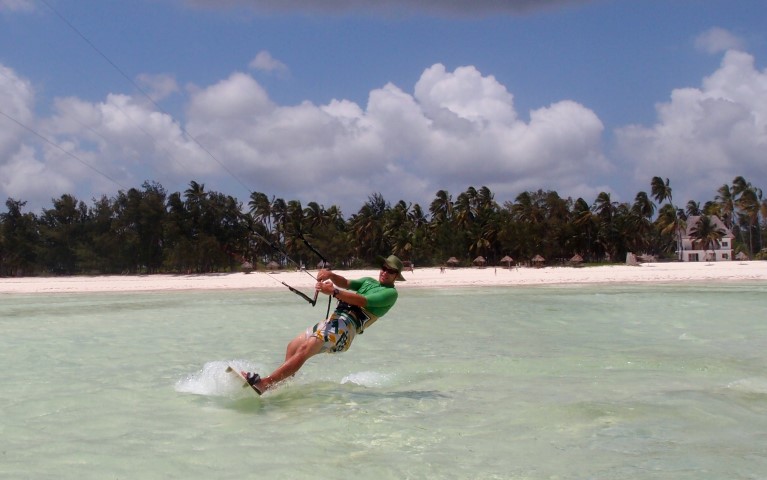
Me kitesurfing – the german look
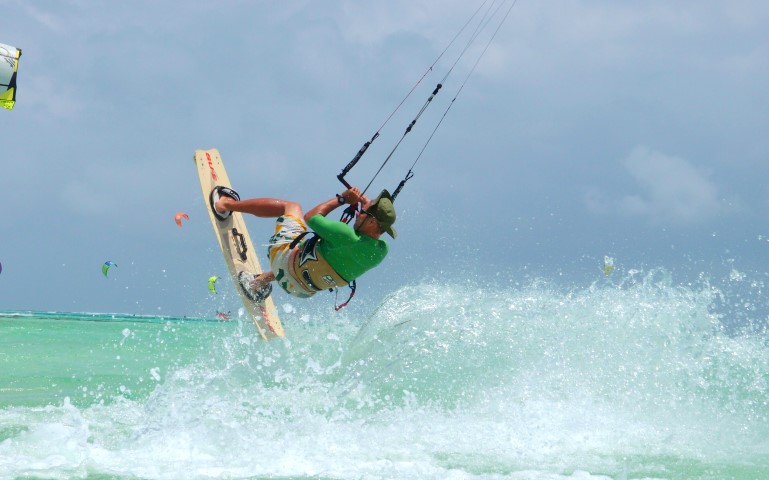
backroll
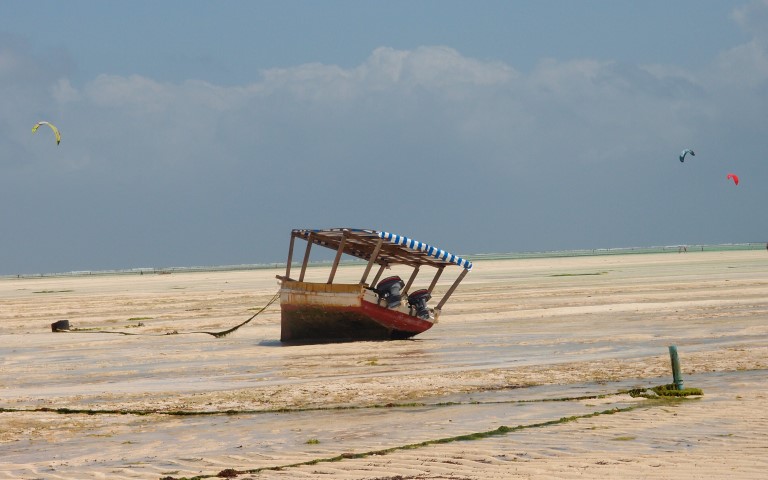
By low tide you need to walk a couple hundreds meters to reach the water
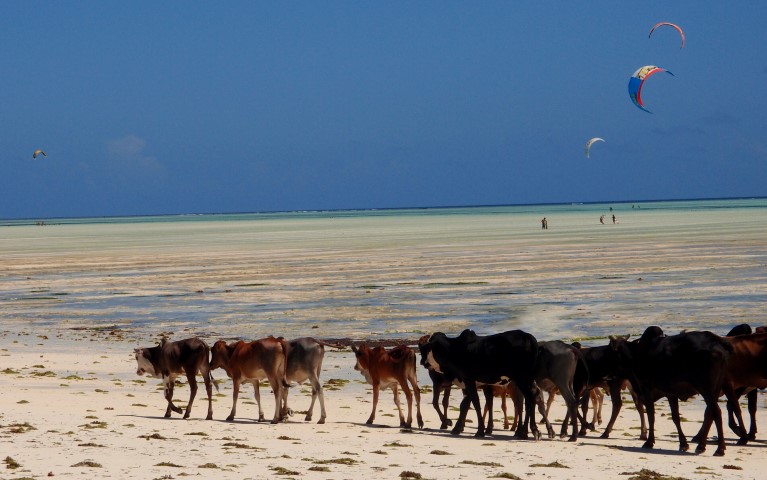
A common view – cows walking on the beach without any advisory. They stop sometimes to watch kites
Most of the kitesurfers stay between the beach and the reef, which is couple kilometers away. The only thing that you need to care about at low tide are the sticks used to farm seaweed. I’ve heard a lot of complaints about those before I came to Zanzibar but in reality they are not that dangerous. All beginners learn behind them anyway and they are very easy to spot. By high tide you don’t have to care about them at all.
Kite Schools
There are several kite schools in Paje (Paje By Kite, Kite Centre Zanzibar, Airborn) offering lessons and gear rental. However, renting is quite expensive – over 300 EUR per week with no insurance. You can buy additional insurance but it still does not cover all types of damage. With such an unpredictable wind I think it’s a lot cheaper to drag your kites with you from Europe 🙂
Some schools also offer kite trips, like downwinders or sand bank kite safari. A whole day trip with lunch and boat costs 80 EUR at Airborn and it strongly depends on the forecast. Downwinders are less expensive. I took part in one organized by Zanzibar Kite Center and it cost 10 EUR for a 1,5h trip. They took us around 5km north to Bellevue village. We started from there and went to the reef, where you can ride the waves up to 2 meters high. Together with my Norwegian friend Erik we were the only riders on twintips, most of the crew were riding strapless wave boards. During that trip there was no rescue boat and the assecuration was provided by experienced instructors. They were very good I admit – they helped Erik when his QR release unexpectedly together with the safety leash! So they caught his kite and waited for him to swim to it – all these in high waves and with strapless boards. Well done guys!
Summary
In general, Paje is a good kitesurfing destination for those of you who would like to learn the sport or experienced guys who would like to visit a beautiful place and occasionally do some kitesurfing as well if wind permits. If you seek after perfect and stable wind conditions then you may get disappointed – better go to Brazil 🙂 Local people say the wind is better in July, but I guess it’s still a lottery.
Activities & Tours
So what can you do in Paje when there’s no wind? Apart from obvious stuff like tanning and relaxing you can go on different trips. Zanzibar is relatively small, so you can take part in all tours offered on the island. Most of the organized tours are quite commercial, so I recommend you trying to do them on your own. This way you learn much more about Zanzibar way of living.
Hunting for Octopus
This trip was actually my favourite one. We asked a local fisherman from Paje if we can assist him while he hunts for octopus. The next morning we walked with him to the reef. The tide was low and the water was knee to chest deep. While we were walking to the reef that guy, Roger, showed us different sea creatures. He spotted things that we’d never see without him e.g. a hilarious puffer fish:
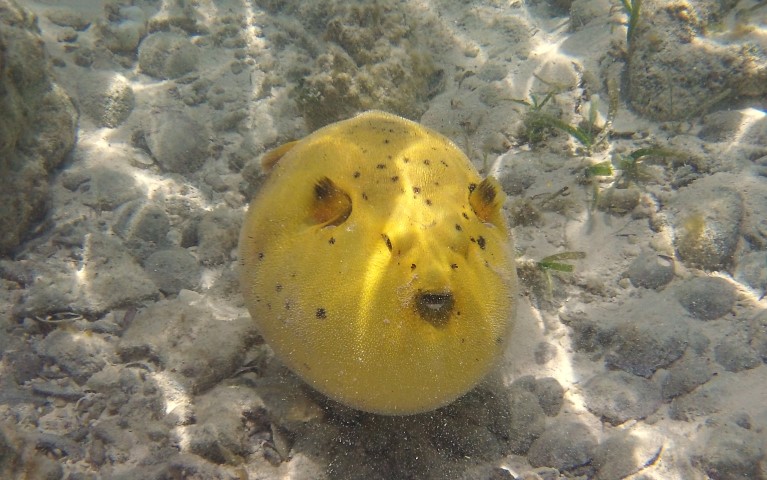
Puffer fish – looks like a yellow volleyball
The closer to the reef the more sea urchins there was. Trying to avoid them was like walking on a mine field, especially in the shallow water, where we couldn’t swim over them.
The most interesting part of the trip was the actual octopus hunting. Roger was armed with a sharp stick and a snorkeling mask only. He knew where to look for them and drag them from under the rocks with bare hands. After he pulled them out of their caves he nailed them with his stick:
The entire trip took around 3 hours. When we came back to the beach Roger started beating his catch with another stick that he found. This was to ensure the octopus is not chewy after cooked or grilled. At the end he offered he can cook those octopuses for us at his place. I agreed to go with him to his house and observe him preparing those. However, when I saw his “kitchen” I got pretty scared of getting sick. For an average European the hygienic conditions were terrible. In addition he admitted that he lives with his mum, who very recently was transported to a local hospital because of high fever. Bon Appétit!
It was a very “local” experience and you will not find it in offerings of any tour operator. That’s one of the reason why it was so much fun!
Dala-Dala
If you want to see other parts of the island I recommend travelling by local buses (so called Dala-Dala) instead of taxis. It’s not only much cheaper but you also get to know local people better. It’s very rare that you meet other tourists in them. Official government Dala-Dalas are open trucks with 2 banks in the back. They can fit as many people as necessary – it seems like there is no such thing as ‘too full’ 🙂 Large baggage lands on the roof. You may be surprised about things people are travelling with. There are also private Dala-Dalas that operate on the same rules but run more often and cost just a bit more. When you go to a bus stop don’t expect any timetables, just ask locals and they will advise you.
Jozani Forest
It’s a common tour that takes you to the Jozani Forest, the only National Park on the island. The entrance cost 8$ and you can take a guide for free, but they expect tips. We didn’t take any guide as I prefer that way. Jozani Forest is a bit like a jungle to me, with many small animals and birds. The main attraction of the forest are world-wide unique Red Colobus monkeys that you can watch from a close distance. To be honest I was more impressed by a giant Monitor Lizard that I met on my way through the forest – it scared the shit out of me 🙂
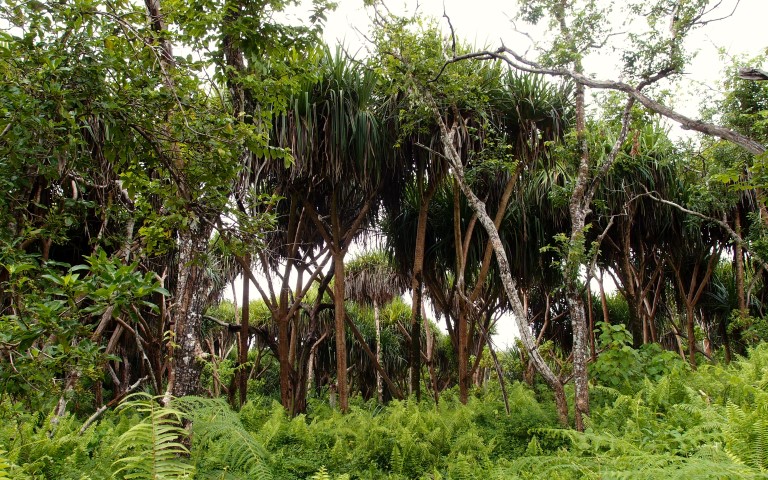
Jozani Forest
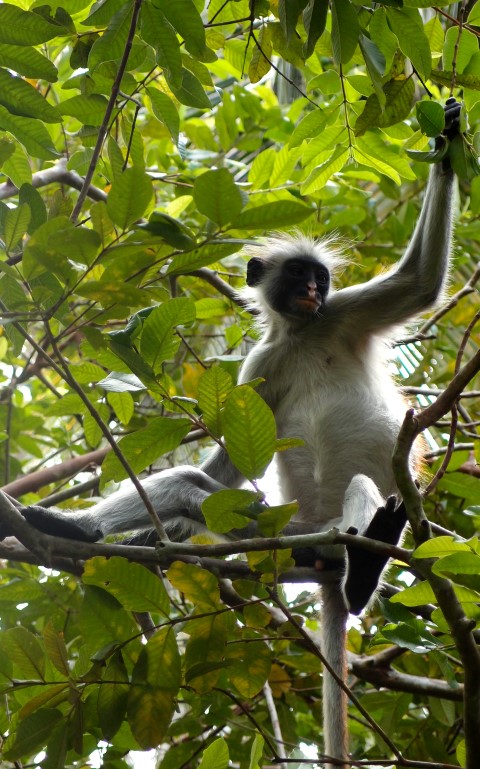
Red Colobus monkey
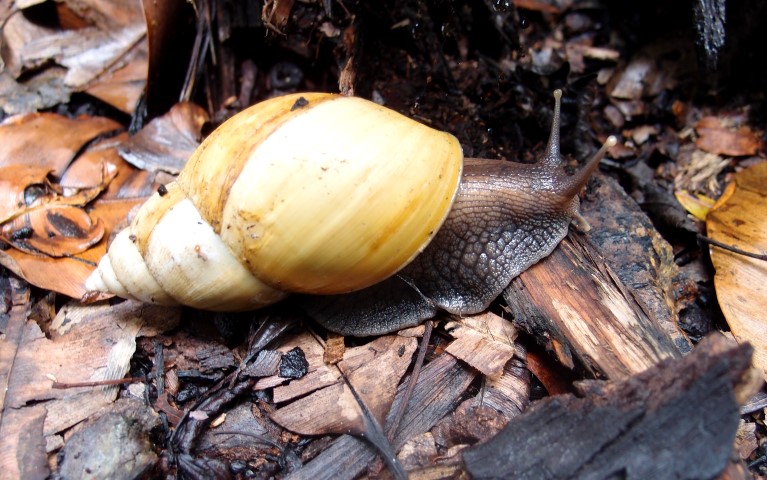
Giant snail
Butterfly farm
It is only 1.5 km away from the Jozani Forest so I recommend you walk along the road to get there. It’s a good opportunity to visit villages that usually don’t get much of tourist attention (remember – have some pens for the kids with you). The butterfly farm itself is nothing spectacular, but the project is very interesting. It was started by a Scottish man, who wanted to help Zanzibar people and thought them how to farm rare butterflies.
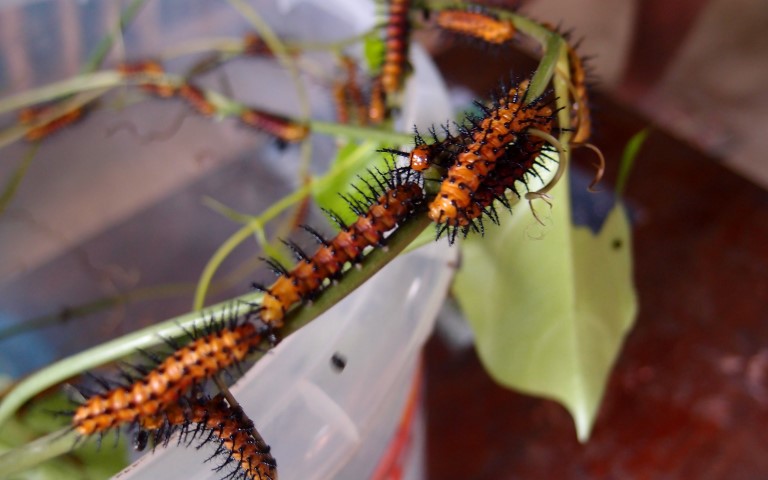
Caterpillars
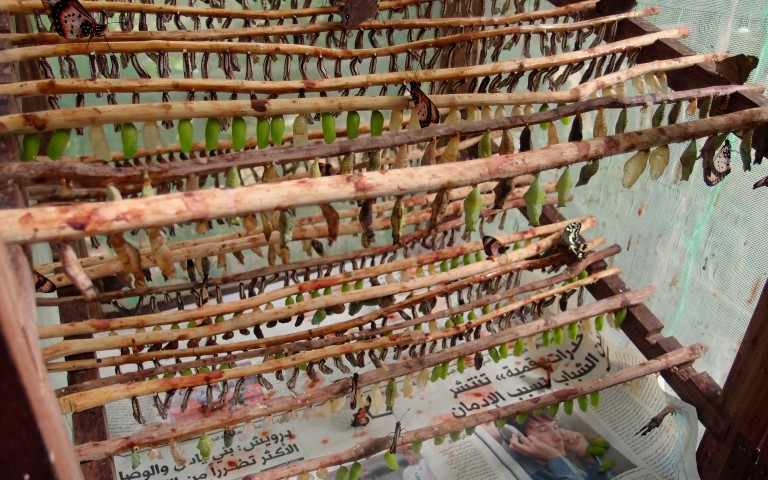
Butterfly cocoons glued to some sticks. This is how they “farm” butterflies
Stone Town + Prison Island
Stone town is a capital of Zanzibar and it takes around 1.5h to get there from Paje by Dala-Dala. The old town is very nice, with narrow streets and stone buildings. It’s definitely worth visiting, but I wouldn’t stay there for long. For me the most interesting part was the local market, where you can buy pretty much everything.
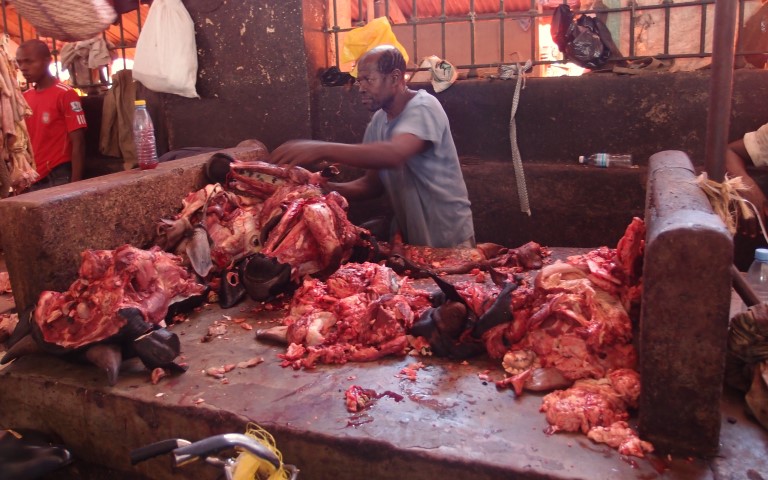
Local butcher – over 30°C and a lot of flies – who’s hungry?
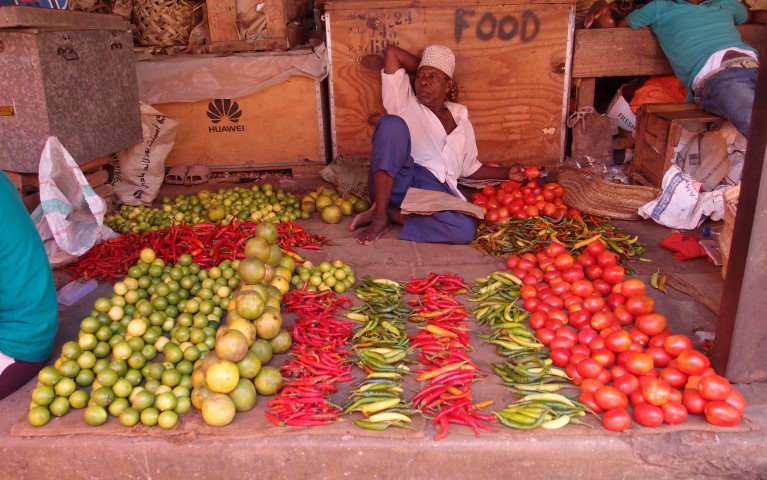
On the market you can find all types of fruits and veggies
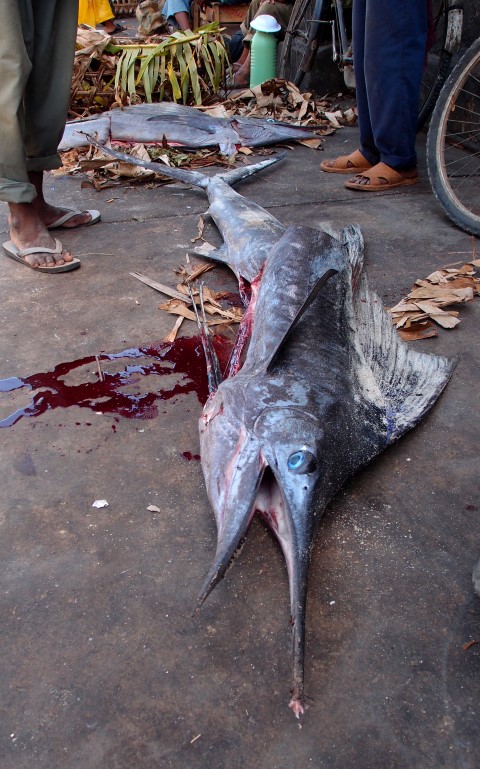
Fish and seafood – they sell it often directly from the ground
From Stone Town you can take a boat to the Prison Island (30$/boat + 4$/person entrance fee). The main attraction of the island are giant tortoises which were brought there from Seychelles. There are almost 200 of them with some being almost 200 years old. It’s worth taking your snorkeling gear as there is a nice coral reef and many fishes.
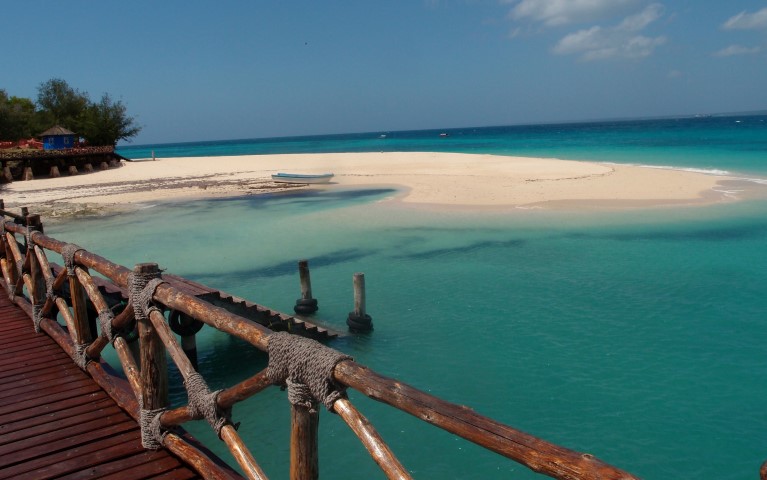
Prison island
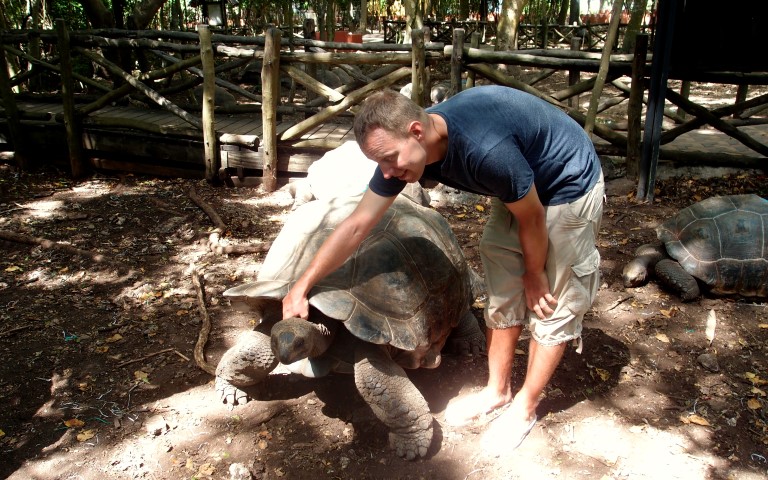
Giant tortoise – if you scratch it it will stand up
Blue Safari
This is the trip I’ve done on a day without wind. To be honest it’s quite boring. It costs 40$ (including seafood lunch) and it takes the whole day. They take you on a sailing or motorboat to a crowded sandbank, where they setup a small tent and tell you to relax 🙂 Then they show you a coral reef island and the mangrove trees that grow on it. The highlight of the trip is the seafood lunch (lobsters, langoustes, calamari, prawns, octopus, you name it…) and coral reef snorkeling. Oh yeah – we saw some dolphins too.
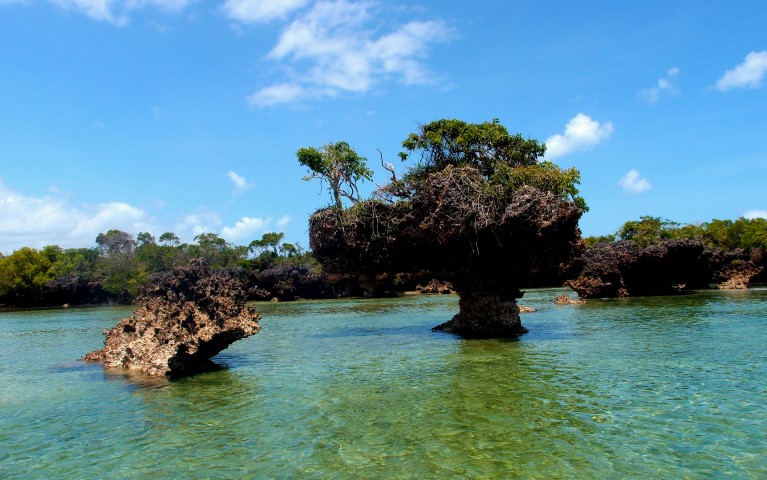
Mangrove trees on a coral reef island
Swimming with dolphins
I signed up for this one but my local guide overslept. Basically you get up in the morning around 6 AM and go to another part of the islands to swim with dolphins. You are back by 9AM so you still have the whole day for you. I talked to some people who did that and they said it’s not really playing with dolphins – they just pass by you with high speed 🙂 Want to try that someday!
Spice tour
It’s one of the most common tours on the island. They get you to a place where they show you how to farm different spice. Zanzibar is used to be known for its spices and slaves. It was the common place for foreign ships to come to buy both. Most popular spices are Vanilla and Ginger, which they believe makes you stronger, especially in bed 😉 Unfortunately I didn’t make that one, but on the other hand I’m not interested in spices that much.
Costs
Let’s talk about money! The entire 2 weeks trip wasn’t that expensive at all, although I was expecting a bit lower accommodation prices. The local currency on Zanzibar is Tanzanian Shillings (TZS), but you can pay with dollars or euros for almost everything. 10,000 TZS is around 6 USD. I recommend to exchange some dollars at the airport, because the conversation rates at many places are very unfavorable. Also, the only cash machines are located only at the airport and in Stone Town. Some restaurants and hotels accept credit cards, but they usually add 5% commission.
Here are some sample prices:
- Travel:
- Taxi from the Stown Town to Paje (~1h) – 60,000 TZS or 35$
- The same route by Dala-Dala – 2,000-4,000TZS i.e. 1-2$
- Drinks:
- 1,5l bottled water at restaurant – 1,500 TZS
- Local beer (Safari or Kilimanjaro) at restaurant – 3500-5000 TZS
- Long Drinks – 7,500 – 10,000 TZS
- Coconut with straw – 500 TZS
- Food:
- Grilled fish (catch of the day) with chips and veggies – 12,000 – 15,000TZ
- Grilled octopus with chips or rice – 15,000TZS
- Lobster – 30,000TZS
- Fish or crab burger with chips – 10,000 TZS
- Fresh fruits on the beach – 1000-2000 TZS
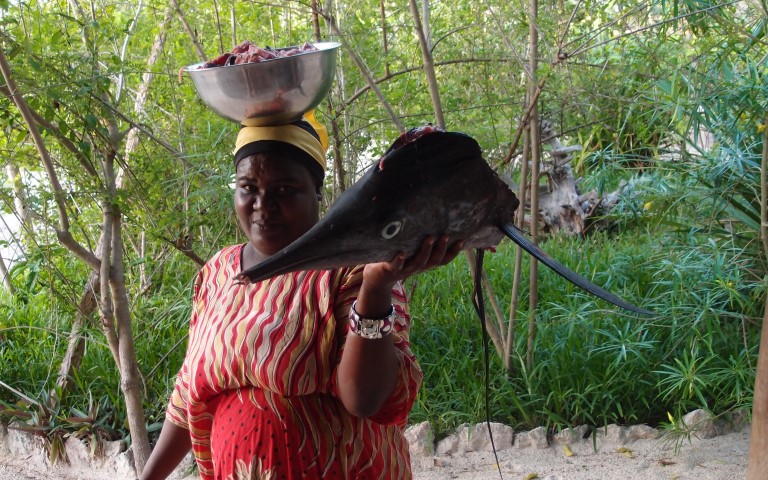
Our cook carries fish to the kitchen
Tips:
- When buying smth from local people always negotiate – my dad would love it 😉
That’s it. I really loved that trip and I hope I’ll be back one day. If you have any questions feel free to contact me.

 |
|